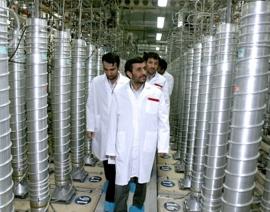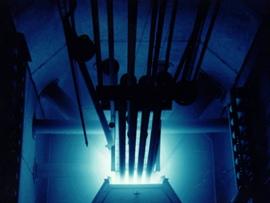
Iran’s civilian research reactor in Tehran, the Tehran Research Reactor, has been much in the news lately. It has an interesting past and perhaps an interesting future. In March of 1974 the Shah of Iran declared that Iran’s goal would be the construction of some twenty power reactors to provide electricity for the country. The Tehran reactor, known as the TRR, was to be used for training students. There is little doubt that the Shah’s goal was to make nuclear weapons. Indeed, after he was overthrown in 1979, the Supreme Leader, the Ayatollah Khomeini, who said he believed that nuclear weapons were un-Islamic, dismantled most of the program. One of the survivors was the TRR. In recent weeks, Iran has claimed that its existence—and need for nuclear fuel—justifies pursuing uranium enrichment to higher levels, ostensibly for peaceful use. Many have doubted that claim, and now the International Atomic Energy Agency (IAEA) has given official weight to those doubts. In its new report, the IAEA for the first time states outright what I outlined in November, that Iran’s enrichment activities may be related to “the development of a nuclear payload for a missile.” To understand why, it is worth considering the history of the TRR.
Located at the Tehran Nuclear Research Center in Amir Abad, a suburb of Tehran, the Tehran Research Reactor went “critical”—its nuclear chain reactions began producing power—in 1967. It was part of the Atoms for Peace program set in motion by President Eisenhower to encourage peaceful uses of atomic energy: developing countries were given grants to buy American made technology such as civilian reactors. The TRR and its clone in Pakistan—the Pakistan Atomic Resarch Reactor (PARR), located near Rawalpindi—were built by the Atomics division of the American Machine and Foundry Corporation, a company better known for making bowling alleys and motorcycles. These reactors are of the “swimming pool” type—the fuel elements sit in a pool of water that is used both to cool them and to moderate the speed of the neutrons emitted in nuclear fission.
A curious feature of the fuel elements supplied by the Atoms for Peace program is that they made use of highly enriched uranium—the kind that is used to make a bomb. No doubt a good deal of the stuff was left over from our weapons program and no one thought that “backward” countries like Pakistan and Iran would have the technological capacity to make nuclear weapons. Some of this highly enriched uranium that went all over the world in the 1950s and 1960s is still unaccounted for.

The TRR is designed to produce about five megawatts of power. A full scale civilian power reactor produces at least a thousand megawatts. Thus the TRR was not meant to be used to generate electricity. It produces medical isotopes (small quantities of radioactive particles that can be used to treat some diseases) and trains students to use nuclear technology. It also produces tiny amounts of plutonium—not enough for nuclear weapons but enough for testing experimental ways of extracting it. The power in this reactor is generated by splitting the uranium-235 nucleus into lighter nuclei along with neutrons. Since the uranium-235 nucleus is essentially destroyed in the process in the course of time the fuel elements in the reactor must be replaced.
When the TRR initially needed new fuel elements it was shortly before the 1979 revolution, and the Iranians chose simply to replace the TRR with a new, safer model of reactor designed in part by Freeman Dyson and manufactured by the San Diego firm General Atomics, which they ordered and paid for. Before it could be delivered, however, the revolution came and General Atomics’ export license was revoked. I do not know if the Iranians got back their money. But they decided to keep the old reactor, the TRR, and buy new fuel elements. In 1987 they signed a $5.5 million contract with the Argentinean Company Investigaciones Aplicados for these fuel elements, which contained 115.8 kilograms of 19.75 percent low enriched uranium. These are the fuel elements that the reactor has used until now and they are in the process of running out. This brings us to the present.
The most straightforward thing the Iranian government could do is to buy new fuel elements from abroad as it did before; I can’t imagine that there would be any objection from the international community or the IAEA to this. Instead, they have announced that they have begun to enrich their own stock of uranium at Natanz, their centrifuge facility in central Iran, to 19.75 percent, in order to supply the fuel for the Tehran reactor. (This enrichment to nearly 20 percent—the internationally recognized dividing line between low enriched uranium, LEU, and the highly enriched uranium, HEU, that is suitable for bombs—was behind Iranian President Mahmoud Ahmadinejad’s claim on February 11 that Iran is now a “nuclear state.”) Making fuel elements out of what is basically uranium hexafluoride gas is not easy; there is no reason to believe that the Iranians have this technology. But they are technologically apt and sooner or later they could acquire it. There are always foreign experts who can be bought. But meanwhile the fuel for the TRR may run out. If the Iranians were sincere about the need to use this reactor to make medical isotopes they would seek a more timely way to refuel it.
Advertisement
More likely, I think, the Iranian government is using the TRR as an excuse for starting the steps that will lead to weapons grade uranium. This possibility is reinforced by the enrichment activities documented in the February 18 IAEA report. At Natanz there are two enrichment facilities—the large FEP and a smaller PFEP. The smaller one is a pilot plant in which the Iranians have installed some of their most advanced centrifuges. As of February 14, they have moved about 1950 kilograms of low 3.5 percent enriched uranium hexafluoride, nearly the entire stock, from the FEP to the PFEP and have enriched some of it to 19.75 percent uranium hexafluoride. The Iranians provided the IAEA inspectors evidence for this but did not reveal how much uranium had been enriched. If they enrich the whole stock it will yield about 200 kilograms of 19.75 percent enriched uranium. At a minimum this is a ten-year supply for the TRR. More plausibly it is more like a twenty-year supply, a good deal more of this uranium than the TRR needs. Once you have 20 percent enrichment, increasing that to 95 percent is much easier than it was to get to the 20 percent. You can think of the uranium-235 nuclei as needles in a haystack of uranium-238 nuclei. The more needles you start with the easier it becomes to look for them. We are rapidly coming to the point of no return.


